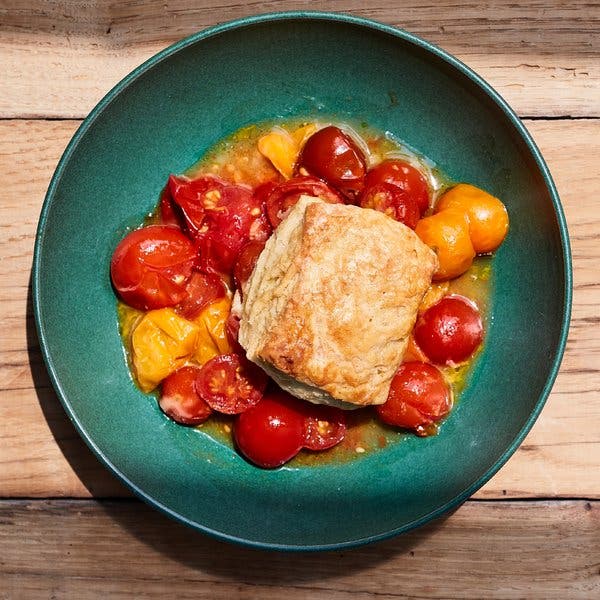I know what you might be thinking, that you don’t really need another biscuit technique, not now. Not when you’ve got that one you already make, tender with lard and chilled buttermilk. Not when you’ve got a whole routine, say, cutting up butter and letting it fall directly into a frozen bowl. Not when you’ve gotten this far just fine on tubs of shortening that never let you down. With biscuits, you find your way by making them over and over, repeating the process until you really get a feel for the dough — the cold fat in long smudged pieces, cushioned in barely bound flour — no part of it tacky and overworked, but no part of it dry and cracking. And once you reach it, the soft, lumpy perfection of biscuit dough, the dusty, rolled-out surface like a sweaty arm that’s been resting right under the air-conditioner, you tend to stick with whatever technique got you there.
My old recipe, the one I never, ever veered from, was all about the butter, chilled for a long time before I cut it, plopped into a specific brand of Southern flour, smushed in a very particular way between my fingertips. I knew the ratios by heart. I made it in big batches for parties, setting aside sheet trays full of rounds to bake over the course of a couple of hours, so they’d always come out hot, then brushing the tops with a little too much melted butter. When I start to think about biscuits, it’s that ratio that still comes to mind. So much so that paging through the chef Nicole Rucker’s new cookbook, “Dappled: Baking Recipes for Fruit Lovers,” I almost skipped the biscuit recipe altogether. I mean, ricotta? In biscuit dough?
It wasn’t my way. But I also figured that Rucker, who made her name in Los Angeles, baking at Gjusta and Gjelina Take Away, whose glorious lime pies at Fiona have barely made it home in my care and whose chocolate-chip-cookie crumbs have been smeared onto countless pairs of my pants, would make every step of her biscuits with care and intention. I also knew her technique would take some getting used to, simply because it wasn’t mine already. It did. Ricotta lies somewhere between liquid and solid, between the biscuit dough’s fat and its binder, and because of this, it messes around with everything I know about biscuits.

CreditJohnny Miller for The New York Times. Food stylist: Maggie Ruggiero. Prop stylist: Colin King.
Ricotta is so wet out of the tub that it’s practically soupy with whey. I don’t trust it, but Rucker strains it first, in a piece of cheesecloth or a fine-mesh sieve. Pressing the extra water out means the dough gets all the soft, cheesy bits, milky as clotted cream, without too much of the extra liquid. Still, like all things biscuit-related, you can’t rely robotically on the exact numbers too much; you’ve got to rely on your hands and continuously accommodate the dough as if it’s a fussy baby. Old, dry flour might want a little extra liquid. Sweaty hands on a hot day might soften the fat too fast and need more time to chill. I found the dough wet, dangerously sticky. I had to add flour as I folded it to keep it from getting tacky. But it got there, and the biscuits were tender as cake, with a beautiful, soft crumb, rising so tall they started to bend to the side, the tops thick with satisfying gold crusts.
You could bake off a tray of these biscuits on a piece of parchment and call it a day, but it’s August, and the tomatoes are excessive. This time of year, Rucker places raw ricotta biscuit dough over a pile of seasoned tomatoes and bakes it all together until the bottom is bubbly and jammy and the top is browned. Adding a small amount of both sugar and vinegar to the fruit heightens the tomato’s inherent tomato-ness, and makes it brighter and sharper, but sweeter too. It makes it more like itself.
When the cobbler comes out of the oven, you can grate aged Cheddar all over the top if you want to make it more savory. Grind black pepper and sprinkle a bit of crunchy salt. But consider this: When Rucker first tipped ricotta into biscuit dough, she expected it to form fine layers of melted cheese. Instead the cheese melted away, leaving no trace of itself, just an impossibly plush, fluffy, milk-colored crumb, exactly soft and sweet enough to set out as dessert.




